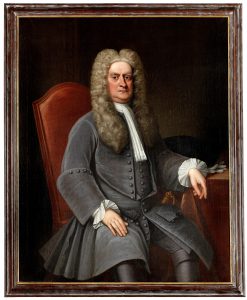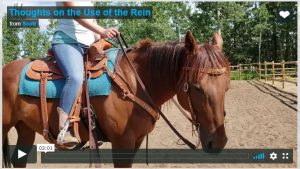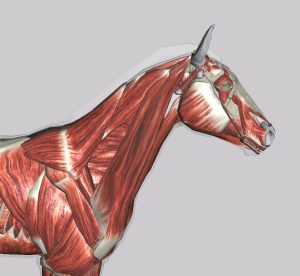For every action…
…there is an equal and opposite reaction.

So states Sir Isaac Newton’s third law of motion.
This is tied in to how you ride your horse in some very obvious ways that you likely haven’t thought about – but when you do it might change how you ride from now on. So lets explore!
Have you ever played the tug-of-war game? It’s a contest in which two teams, or two people, pull at opposite ends of a rope until one drags the other over a central line. We did this quite a bit as kids, and usually there was a mud puddle in between us!
Lets consider a hypothetical example: Jim and Bob are pulling on opposite ends of a rope. If neither Jim nor Bob is moving, then both are pulling exactly the same amount, but in opposing directions. If Jim is pulling with 50 pounds of force, then Bob must also pulling with 50 pounds of force. It’s a stalemate. Follow me so far?
I want you to think of what is actually going on in our bodies to produce that 50 pounds, or the pulling force itself. That’s right – muscles (in combination with bones and ground friction, but we won’t get into that)! For us to push, pull or move involves our muscles activating. When muscle fibers are on, they tighten or contract. That is the only thing a muscle can do. Therefore, pairs of muscles are required to produce an opposite motion; one muscle in the pair will activate while the other muscle relaxes.
Still with me?
Lets say the rope between Bob and Jim is slack; it has no tension. Neither Bob nor Jim have activated any muscles yet. Now, Bob starts to pull on the rope. Immediately Jim matches that pulling force. So what just happened there? Bob caused Jim to activate muscles. We know that Bob’s desire is to move Jim. But the muscles that have activated are actually causing Jim to pull in the opposing direction! Remember, every force has an equal and opposite force. To prove that theory all Bob has to do is let go of the rope. Which way is Jim going to go flying? Backwards of course, not forwards (the direction Bob desires him to move).
Consider this in the use of the lead rope. Again, this is something obvious that we generally don’t consider: if you pull forward on the lead rope and the rope becomes tight, it is tight because you have caused the horse to engage muscles to oppose that motion. You have caused the horse to pull in the opposite direction that you intended! Basic physics at work. If the horse was not engaging muscles to pull opposite your intent then the lead rope would be slack and the horse would be moving with you.

Now consider one more part of the equation: the harder we pull the more difficult we make it for our horse. Again, this is makes complete sense when you think about it. Let’s say you’re pulling on that lead rope with 25lbs of force. We now know that means your horse is pulling the opposite direction with 25lbs of force. So in order for him to move, he has to release 25lbs of pull! This is quite a contrast to the tension that should be in the lead rope: about the weight of a pencil. That is easy for him to release to.
Pause for thought:
A horse can cause another horse to move in any direction without even making physical contact, in fact, by barely moving at all. And so can we when we learn to communicate with them. So why, then, do some we resort to pulling and yanking on a lead rope or rein? Here’s a two part answer.
- We have arms. Because of this uniqueness, we are used to being able to move things by pushing and pulling. But most of the time, those things are inanimate. They don’t think. They don’t have fears. Like a grocery cart or a sled. Pushing and pulling to move those things is a no-brainer. But with a horse, an animal that thinks, we need to cause him to want to move instead of try to pull or force him.
- When we don’t understand how something works or lack the skills to communicate in another language, humans typically turn to control. As in, “I don’t understand it, but I can certainly control it.” You’ve heard people say, “Control is an illusion.” This is true, but in the case of a horse, who may get scared or isn’t doing what we want, we sometimes resort to force to accomplish our goals. Its never a winning game. Lets step in with some positive leadership instead, and find ways to assist him. Consider your role that of an athletic coach.
I’ve helped more than one person who has had the complaint that “The horse is pulling on the reins.” In order for the horse to do that though, you need to be pulling with exactly the same amount of force. And I mean exactly. Because if the rein is not moving then the horse’s muscles are engaged to exactly the same amount yours are.
Alright. Quiz question! I know you’ll get this right.
What’s the solution to prevent the horse from pulling on the reins?
You got it – don’t give him anything to pull on! A tug of war can never happen if only one team pulls – because the rope will never have tension. In the context of Jim and Bob, think of it this way: Bob picks up the rope. As soon as Jim feels that rope move a tiny bit, he steps forward. When he does this, he releases any tension in the rope before it gets tight.
This is really important because, as we know, the primary function of the rein is to support the horse in using his body athletically and in balance by asking specific muscles to either release or engage. In the context of this conversation, we’re asking the horse to release muscles in the top part of his neck, which connect to the poll. What we see when the horse releases those muscles is in most texts referenced as movement of the jaw or poll.
Tightness in the rein will prevent this from happening. Continued work with a tight rein forces the horse to move through brace (mental and muscular tension) resulting in some very undesired consequences, including injuries that require therapy. Not only that, but the horse will learn that the lead rope or rein can produce pain. In that case he’ll learn to brace before you even pick the rein up. I’ve helped many a horse like this so the good news is that we can certainly fix it. These amazing animals will give us a second chance.
Our style of horsemanship ensures that the training experience for the horses (and owners) is positive, so that they learn to trust and let go of fear and tension – and in that state we can produce the highest degrees of athleticism – far beyond what you can attain through forcing a horse into submission and obedience.
It’s not a big undertaking, either. A simple understanding of how horses think and how their bodies work might take you a few hours. We go through the basics in all of our clinics. The problems we have with horses typically stem from one thing – not understanding why they’re doing what they’re doing.
Our perception of problems is exacerbated by misinterpretation and generally personification – trying to explain what the horse is doing by comparing him to a human. That is natural for us, in fact, it’s a known psychological phenomenon. You can read more about that in this article. When we put effort into understanding the horse, things get easy. The horse is a very simple animal once we understand him.

Explaining Resistance.
Have you ever heard of resistance training? It’s a type of strength training where resistance is used to build muscle. A Bowflex is a good example – you build muscles by pulling on cables attached to flexible rods. As the rods bend, they provide resistance – pulling against you. This causes your muscles to engage, giving you a workout and building muscle.
Guess what? The rein can be a Bowflex too, because as soon as the rein is tight – the horse is turning on muscles to resist you. You are not only building your own arm muscles but building muscles in the horse – muscles that prevent him from moving athletically.
Now that you’re aware of this, here’s a tip – if anyone asks you to pull harder, yank, take excessive contact or the like – you now know better. Your best option: simply take 5 minutes to explain this basic theory to them. Refer them to this article or to any equine practitioner or trainer that understands horse physiology and can explain the why, not just the how.
Light on the Reins.
We all desire a horse that is light on the reins – that is, he is able to respond to the slightest feel of a rein. That goal can never be reached if we don’t give him the chance to do so. If the horse isn’t responding to the rein, pulling the rein harder is not a good solution. It might seem like it is, after all for us humans, if something doesn’t move, we just push it harder, right? Not in the case of a horse – remember, he’s a thinking, feeling animal.
 There are several reasons a horse will not respond to a light feel: fear, leadership issues, not knowing how to respond to pressure, expectation that he’ll get his face yanked on or distraction.
There are several reasons a horse will not respond to a light feel: fear, leadership issues, not knowing how to respond to pressure, expectation that he’ll get his face yanked on or distraction.
Ever see a horse that jerks his head up or rears? It’s a trained behavior. Horses that have been yanked on learn to pull. Every action has an equal and opposite reaction, remember? Sometimes it can be tempting to jerk on a lead rope to get the horse’s attention, but the negative consequences of that far outweigh any momentary fix we might get.
The point is, we DON’T want to teach the horse that the lead rope or rein will cause him discomfort and pain. We DO want to use the lead rope or rein to cause the horse to release muscular and mental tension.
What is the better way?
There are a few important pieces which go into the answer. We’ll look at two fundamental requirements:
- FOCUS. We train our horses that when there is stress or distraction, that the answer is always to focus on us. When they do, they can then follow our focus. But before that can happen, we must be presenting a focus [read more about this here]. We also learn how to use pressure as a positive cue, and teach the horse that the response to pressure is to release tension and focus on us. Many times our problems result due to a lack of focus. This could be because another pressure has drawn their attention (like a deer jumping in the trees) or because they have been trained to ignore us (very common scenario in lunging / round-penning exercises where thought is given to the horses body but not his mind).
- LEADERSHIP. We need to be the leader in a herd consisting of us and our horse. We often have a grey area in our leadership agreement with our horses. Even I find myself having to detail that agreement once in a while – we’re all human and we get sloppy. When we are the leader though, we can work with both a dominant horse and a fearful horse the same way. We touch on all those details in every clinic but get really into it in the Progressive Horsemanship and Liberty to Riding clinics. The point being, that when the pressure is on, the horse will defer to following the leader – you, versus another horse, or himself.
When these pieces are in place you’ll find that you no longer have a need to get tight on the rein or lead rope. Here’s a little example of what I’m talking about.
When things are not going right.
If you feel you’re in a position where you think you have to pull or jerk on a rope or rein, first of all, DON’T (unless your life depends on it). Take a deep breath and evaluate the reason. It’s likely one of the following:
- The horse is focused on something else,
- The horse is scared and thus fleeing or freezing,
- Or the horse feels he is above you in the herd and therefore you should be following his lead.
In my clinics we focus on each of those three things. We discuss use of the lead rope and rein and how exactly to use it to assist in building softness and athletic ability. We explore the bio-mechanics of the horse and exactly what goes on in his body (and mind) to produce the motions we desire – and how the rein, seat and legs assist that. This knowledge is a fundamental part of riding.
The fantastic part of this is that these principles apply to every discipline and every horse in existence. The reason is this: the horse is a horse. His mind and body work the same way regardless of the discipline he’s ridden in. Once we have this basic understanding and some practice, we can apply it to whatever we do – with lasting success. Hats off to Sir Isaac Newton!
Scott Phillips
July 2018
